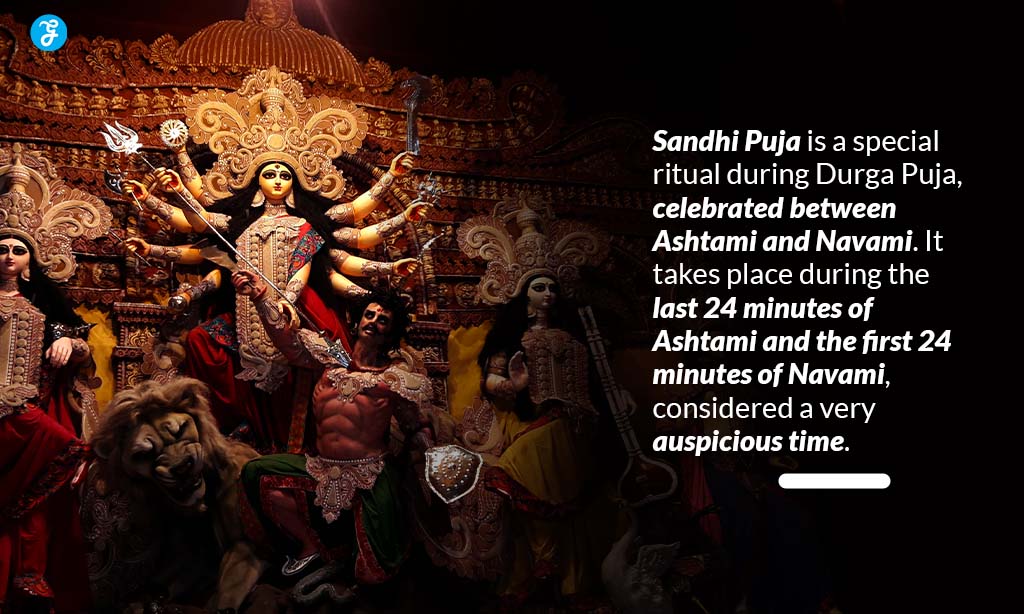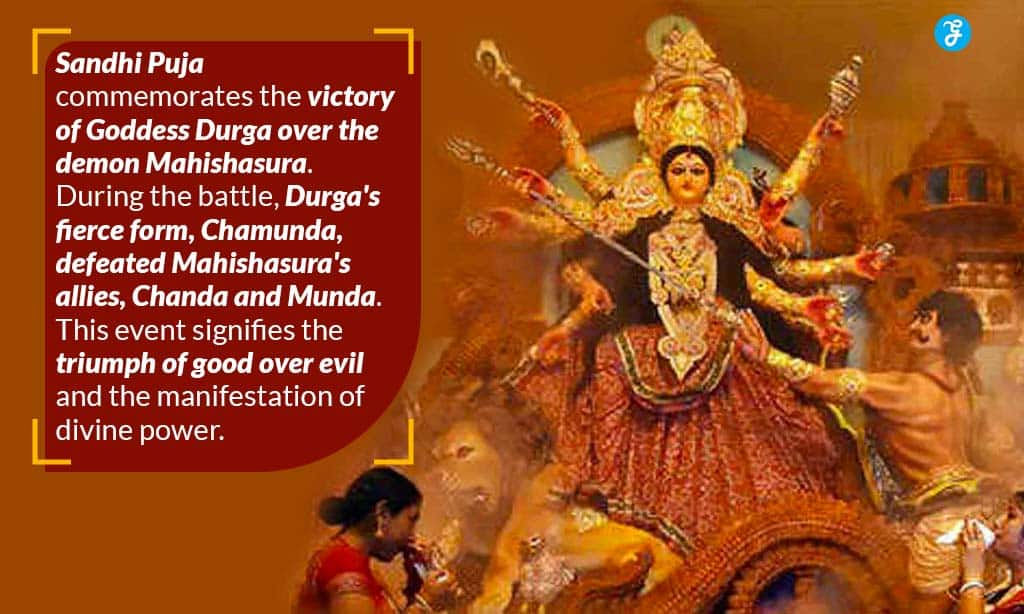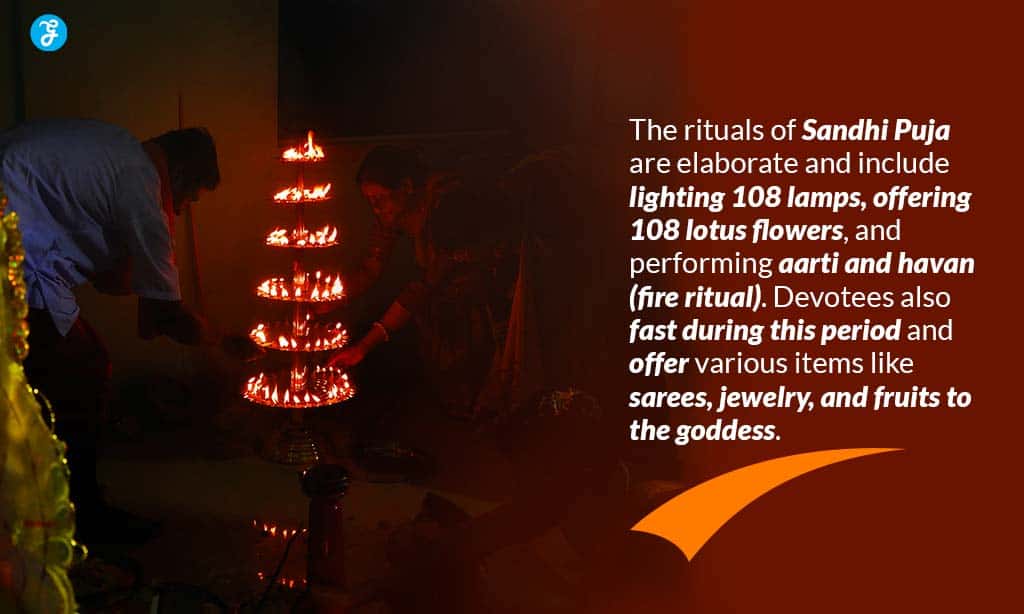In the vibrant tapestry of Hindu festivals, Durga Puja stands out as one of the most colorful and significant celebrations. At the heart of this grand festival lies a particularly powerful ritual known as Sandhi Puja.
This sacred ceremony, performed at a specific junction during the festivities, holds immense spiritual importance and is steeped in rich symbolism and tradition.
In this article, we will look into the significance, history, and rituals of Sandhi Puja.
The Significance of Sandhi Puja
Sandhi Puja, as the name suggests, is performed at a crucial juncture or “sandhi,” during Durga Puja. The term “sandhi” in Sanskrit means “junction” or “union,” while “puja” translates to worship. This auspicious ritual takes place at the intersection of Ashtami (the eighth day) and Navami (the ninth day) of the Durga Puja festival.
The timing of Sandhi Puja is precise and holds great significance. It lasts for exactly 48 minutes—the last 24 minutes of Ashtami and the first 24 minutes of Navami. This specific timeframe is believed to be when the divine energy of Goddess Durga is at its zenith, making it the most potent moment for worship and spiritual practices.
Spiritually, Sandhi Puja symbolizes the eternal battle between good and evil, with good ultimately triumphing. It represents the moment when light overcomes darkness and wisdom prevails over ignorance. Devotees believe that prayers offered during this time are especially powerful and more likely to be answered.
Historical and Mythological Background
The origins of Sandhi Puja are deeply rooted in Hindu mythology and are intrinsically linked to the legend of Goddess Durga. According to ancient texts, it was during this sandhi period that Goddess Durga, in her fierce form as Chamunda, slayed the demons Chanda and Munda.
The story goes that these two powerful demons were wreaking havoc and destruction. When they attacked Goddess Durga, she assumed the terrifying form of Chamunda. In a fierce battle that reached its climax during the Sandhi period, Chamunda decapitated both demons, thus restoring peace and order to the world.
This mythological event is commemorated through Sandhi Puja, celebrating the victory of good over evil and the protective power of the Divine Mother. The ritual serves as a reminder of the constant need to vanquish negative forces and cultivate positive energies in our lives.
Rituals and Practices of Sandhi Puja
Sandhi Puja is characterized by a series of elaborate rituals and practices that have been passed down through generations. The preparation for this sacred ritual begins well in advance, with devotees often fasting from the beginning of Ashtami until the completion of Sandhi Puja.
One of the most striking visual aspects of Sandhi Puja is the lighting of 108 lamps. This number holds special significance in Hinduism, representing the 108 names of the Divine Mother. Alongside these lamps, 108 lotus flowers are also offered, creating a mesmerizing spectacle of light and beauty.The offerings made during Sandhi Puja are diverse and symbolic. Fruits, sweets, and various other items are presented to the Goddess. In some traditions, animal sacrifices were once a part of the ritual.
However, in modern times, many communities have replaced this practice with vegetable offerings, maintaining the spirit of the tradition while adapting to contemporary values. Throughout the puja, priests and devotees chant powerful mantras and hymns. The air resonates with the sound of conch shells and bells, creating an atmosphere charged with spiritual energy. The most important mantra during this time is the Chandi Path, which narrates the glory of the Goddess.
Regional Variations of Sandhi Puja
While Sandhi Puja is most prominently celebrated in Bengal, where Durga Puja is the biggest festival of the year, it is also observed in various other parts of India. Each region brings its own unique flavors and customs to the ritual. The beating of drums (dhak) and blowing of conch shells are frequently associated with Sandhi Puja in Bengal.
The atmosphere is electric, with devotees gathering in large numbers to witness and participate in the rituals. In some pandals (temporary structures where the Goddess is worshipped), 108 earthen lamps are arranged in the shape of a lotus, adding to the visual spectacle.
In other regions, such as Odisha and Assam, while the core elements of Sandhi Puja remain the same, local traditions influence the way it is conducted. For instance, in some places, special regional delicacies are prepared as offerings during this time.
The Experience of Sandhi Puja
Experiencing Sandhi Puja is often described as a profound and moving event. The atmosphere during these 48 minutes is charged with intense devotion and spiritual fervor. Devotees often report feeling a sense of divine presence and heightened spiritual awareness during this time.
The community aspect of Sandhi Puja is also significant. It brings people together in a shared expression of faith and tradition. The collective energy of hundreds or thousands of people united in prayer and devotion creates a powerful and memorable experience.
Modern Interpretations and Relevance
In today’s fast-paced world, Sandhi Puja continues to hold relevance, albeit with some modern adaptations. In urban settings, where traditional 48-minute pujas might be challenging to organize, some communities have adjusted the timing while maintaining the essence of the ritual.
The diaspora communities around the world have also embraced Sandhi Puja, often incorporating it into their Durga Puja celebrations. This global spread has led to interesting fusions of traditional practices with the local customs of the host countries.
Moreover, the symbolic battle of good over evil that Sandhi Puja represents continues to resonate with contemporary society. Many see it as a time for personal reflection, to overcome one’s inner demons and negative tendencies.
Takeaways
Sandhi Puja stands as a testament to the rich spiritual and cultural heritage of Hinduism. It encapsulates profound philosophical concepts within its rituals and symbolism. From its mythological origins to its contemporary practice, Sandhi Puja continues to be a pivotal moment in Durga Puja celebrations.
This sacred ritual not only preserves ancient traditions but also provides a moment of spiritual connection and community bonding in our modern world. As the lamps are lit and the chants rise, Sandhi Puja reminds us of the eternal struggle between light and darkness, and the ultimate triumph of good over evil. It remains a powerful expression of faith, culture, and the enduring human spirit.













































